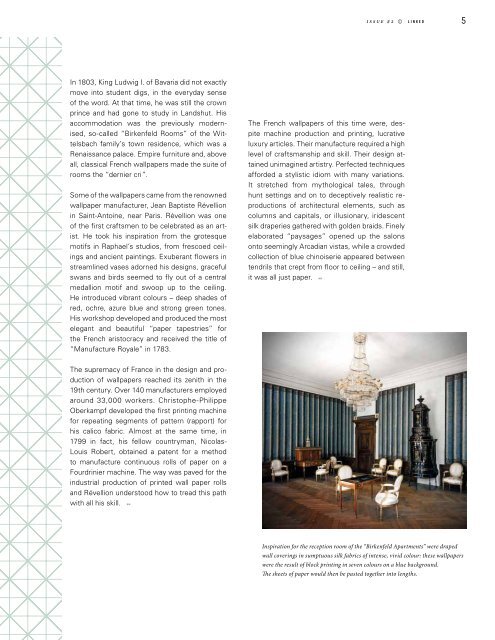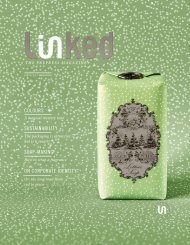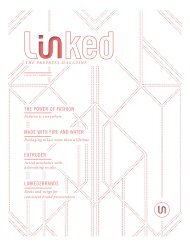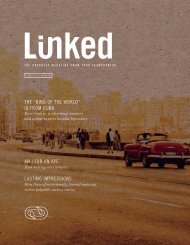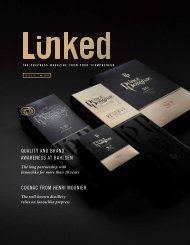Janoschka magazine_Linked_V2_2017
Create successful ePaper yourself
Turn your PDF publications into a flip-book with our unique Google optimized e-Paper software.
issue #2 ©<br />
l i n k e d<br />
5<br />
In 1803, King Ludwig I. of Bavaria did not exactly<br />
move into student digs, in the everyday sense<br />
of the word. At that time, he was still the crown<br />
prince and had gone to study in Landshut. His<br />
accommodation was the previously modernised,<br />
so-called “Birkenfeld Rooms” of the Wittelsbach<br />
family’s town residence, which was a<br />
Renaissance palace. Empire furniture and, above<br />
all, classical French wallpapers made the suite of<br />
rooms the “dernier cri”.<br />
Some of the wallpapers came from the renowned<br />
wallpaper manufacturer, Jean Baptiste Révellion<br />
in Saint-Antoine, near Paris. Révellion was one<br />
of the first craftsmen to be celebrated as an artist.<br />
He took his inspiration from the grotesque<br />
motifs in Raphael’s studios, from frescoed ceilings<br />
and ancient paintings. Exuberant flowers in<br />
streamlined vases adorned his designs, graceful<br />
swans and birds seemed to fly out of a central<br />
medallion motif and swoop up to the ceiling.<br />
He introduced vibrant colours – deep shades of<br />
red, ochre, azure blue and strong green tones.<br />
His workshop developed and produced the most<br />
elegant and beautiful “paper tapestries” for<br />
the French aristocracy and received the title of<br />
“Manufacture Royale” in 1783.<br />
The French wallpapers of this time were, despite<br />
machine production and printing, lucrative<br />
luxury articles. Their manufacture required a high<br />
level of craftsmanship and skill. Their design attained<br />
unimagined artistry. Perfected techniques<br />
afforded a stylistic idiom with many variations.<br />
It stretched from mythological tales, through<br />
hunt settings and on to deceptively realistic reproductions<br />
of architectural elements, such as<br />
columns and capitals, or illusionary, iridescent<br />
silk draperies gathered with golden braids. Finely<br />
elaborated “paysages” opened up the salons<br />
onto seemingly Arcadian vistas, while a crowded<br />
collection of blue chinoiserie appeared between<br />
tendrils that crept from floor to ceiling – and still,<br />
it was all just paper.<br />
The supremacy of France in the design and production<br />
of wallpapers reached its zenith in the<br />
19th century. Over 140 manufacturers employed<br />
around 33,000 workers. Christophe-Philippe<br />
Oberkampf developed the first printing machine<br />
for repeating segments of pattern (rapport) for<br />
his calico fabric. Almost at the same time, in<br />
1799 in fact, his fellow countryman, Nicolas-<br />
Louis Robert, obtained a patent for a method<br />
to manufacture continuous rolls of paper on a<br />
Fourdrinier machine. The way was paved for the<br />
industrial production of printed wall paper rolls<br />
and Révellion understood how to tread this path<br />
with all his skill.<br />
Inspiration for the reception room of the “Birkenfeld Apartments” were draped<br />
wall coverings in sumptuous silk fabrics of intense, vivid colour: these wallpapers<br />
were the result of block printing in seven colours on a blue background.<br />
The sheets of paper would then be pasted together into lengths.


